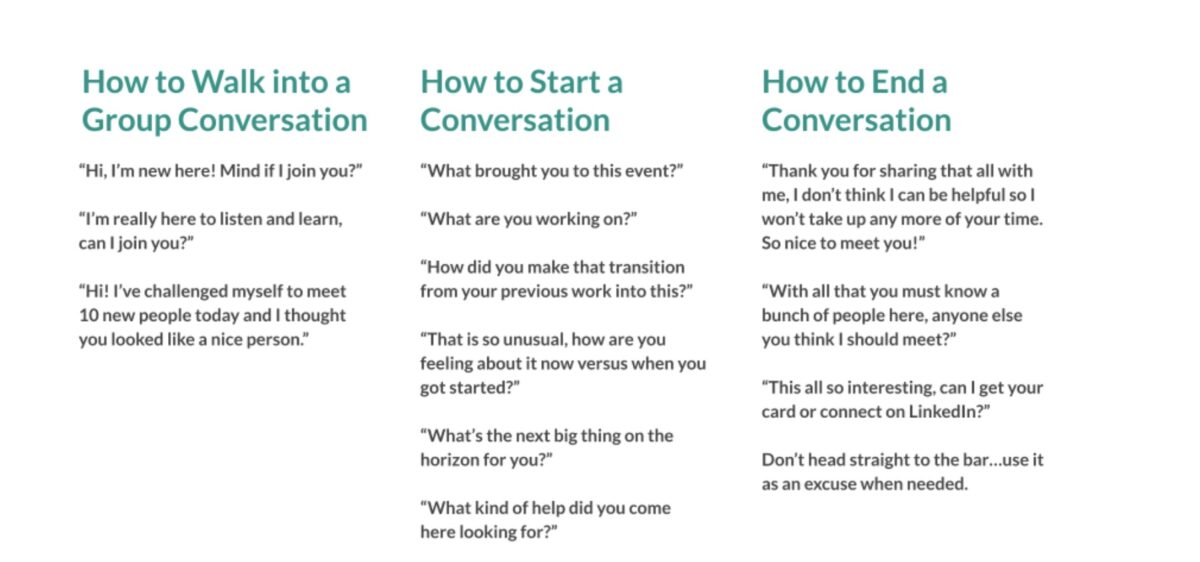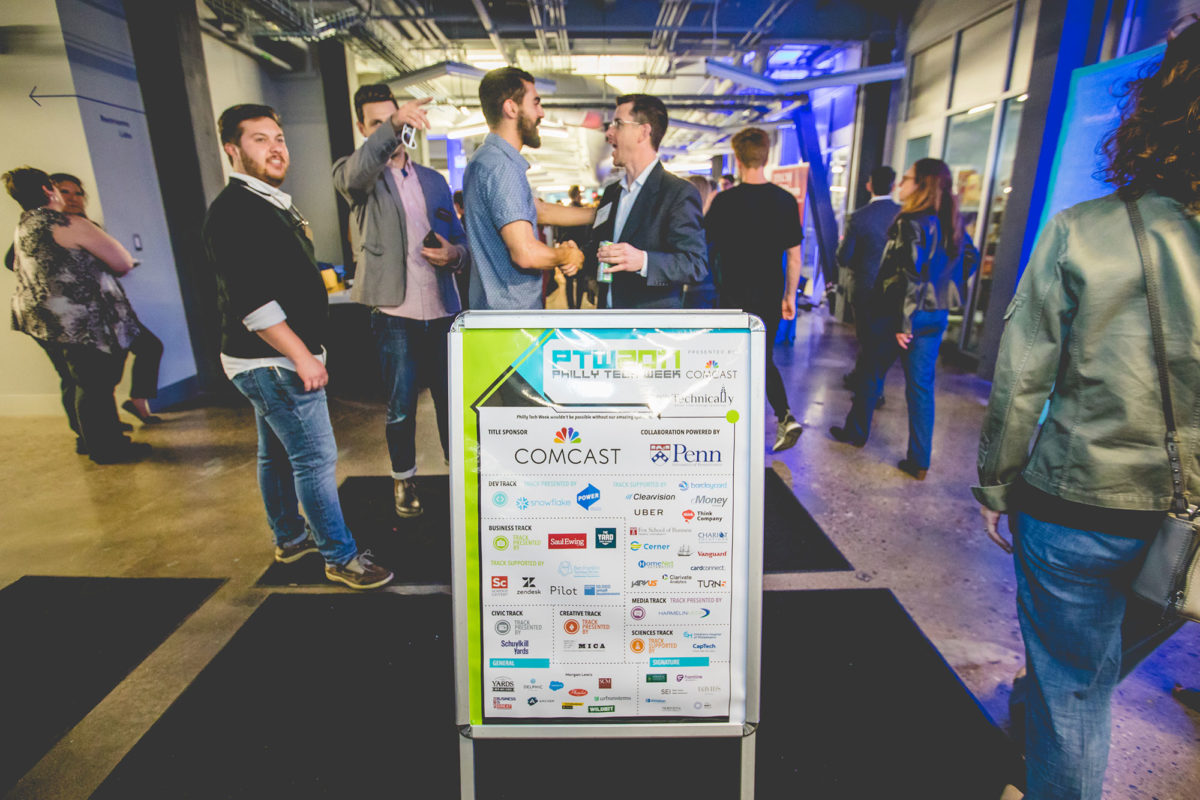You’ve just registered for your next big conference. Maybe it’s Philly Tech Week 2023 presented by Comcast. Regardless, you’ve bought the badge, read through the schedule and booked your hotel. You already searched conferenceparties.com, registered for a few events — and then, the anxiety sets in.
There’s going to be so many people there! How the heck am I going to meet people? What do I do once I get there?
While many people get lucky and have fortuitous interventions, landing in the same elevator or next to their next best friend or relevant lead at the keynote, some things are better architected than left to chance. The big secret to conferences: It’s all in the prep.
Take these five pro-moves with you to your next conference to maximize the investment of your time and help you achieve your goals:
Be the person that shows up and stays
It’s fun to sign up for every panel or happy hour or side event, so register away! Who knows who you might meet! But there’s something to be said for not living in the frenzy. Hopping from one thing to the next means you might miss the opportunity to get into a real conversation and make a deeper connection. That’s why it’s critical to bring the decision of where to spend your time back to your goals.
Do the research to find and source the chances to be in the places where you want to be included. Sometimes, that will mean asking others to invite you to what they are going to — almost everyone likes to attend an event with a friend and welcomes this ask.
Once you get there, be the person that shows up early and stays late. Both of those extremes are where good conversations happen.
Make a networking game plan
Alright, you’ve committed to your events, so now what? Have a plan, using these three components to make one: the research, the rules and the art of the chat.
First, do your research. Find out who’s attending that you want to get to know. This takes some sleuthing. Go through:
- The entire speaker list — A session might not be right for you, but a particular speaker could still be relevant. Make sure you read them all.
- The organizers list — They are often the most thoughtful group of people at the whole event, they know everyone and are there to network, too!
- The attendee list, if provided — Obvious, hopefully in an app, completely worth it, but time-consuming and most people won’t invest the time.
- LinkedIn, Twitter, Reddit — See if anyone posts about the event in advance. If they are, they’re probably a go-getter and someone you want to meet.
Execution of the networking game plan also requires making some rules that align with your goals for the event. Three to start with:
- Commit to meeting 10 new people. Treat this like a KPI: You hit it or you don’t. No excuses.
- If you came with a friend, split up. Come together to check in, take a beat, and then keep going. Having a partner to hold yourself accountable and rejuvenate after talking to people you don’t know reduces stress.
- If this is a sit-down event, do not, no matter how tempting, sit down with your friends. That’s your comfort zone. You can hang out with them after the work is done!
Now, how do you start the chat? There is still nothing more awkward and middle-school triggering than walking up to a group of people you don’t know and trying to strike up a conversation. You just have to do it, though. Every skill worth building takes practice. Try out these starters, continuers and enders to converse with confidence:

Build a double schedule
With any good event, you’ll find yourself wishing you had a time-turner and could attend more sessions than possible. When there’re too many options, force some structure on yourself. The best way to do this is to build a double schedule in advance —meaning that for every session block, you’ve pre-selected two sessions that you’d like to go to.
This does two things: It takes care of the decision-making stress of “where to go next” before the conference so that you’re not wasting time trying to navigate a scheduling app, as well as gives you the confident flexibility of knowing that you have two great options. Once you’re in the moment, go wherever is closer or most interesting to you.
You’ll find that this pre-work frees up your brain to have those serendipitous conversations in the hallway or the coffee line because you’ve made a plan and aren’t hovering over your phone.
Have event presence
In a way, conference presentations are designed to be passive content you consume. You’re listening, you’re learning, taking it in. But put yourself in the panelists’ shoes for a minute — staring out into a sea of faces, many illuminated by multi-tasking, email-sending mini-computers. Is anyone even listening? Am I making any sense? Does anyone care?
You can be someone that answers their internal anxieties with affirmation. As soon as they are ready for Q&A, be the first one on the mic. Say your name, the eight-second version of who you are, and ask your question concisely. The speakers will remember you and you’ll suddenly become someone that everyone in the audience has an ice-breaker with.
Do this and you’ll be amazed at how many people will come up and introduce themselves throughout the event because they had the same question that you did, and you opened yourself up to conversation. Now you have created a presence!
Nail the follow-up
It’s all over, you learned, you met great people and had interesting conversations. Now you must begin the work of turning them into relationships. It starts with these immediate follow-ups:
- Send a LinkedIn message to all the speakers with a customized message. You’ll use this for your own reference in the future as LinkedIn messages never go away, so you can always go back and see when and why you connected with them.
- Send a thank you note to each of the conference organizers. They are the magical people that know every single person that was at the event, and you never know when that one degree of separation will come in useful. Also, they deserve it! And they are often forgotten!
- Create the artifact of your time at the event: Write a recap, share a few things you learned or simply say thank you to the organizers and speakers that you appreciated the most. Not only is this gracious, but it’s good for you to make some time to process the time investment. It’s also one more touchpoint to cement the memory of who you were to the new connections you made.
- Commit to truly timely follow-up conversations. This may be the hardest part — there’s nothing like getting home after a great conference and finding yourself buried in an inbox mountain. If you said you would follow up, do so within three business days of the conference’s last day. The people on the other end of those emails in your inbox are already waiting for you. The people you just met are not. Send those connection emails and get next steps scheduled before you let your day-to-day routine take you back.
To hit the point home here — attending a great event is easy. You show up, you listen, you take some notes and you talk to some people. Using a great event to drive your business goals and build your network takes work.
If you commit to preparation, you’ll achieve your goals and turn your experience from a passive one into an active one with a long-lasting impact.
You can meet Falzon during the Builders Conference and Signature Event at Philly Tech Week next week.







